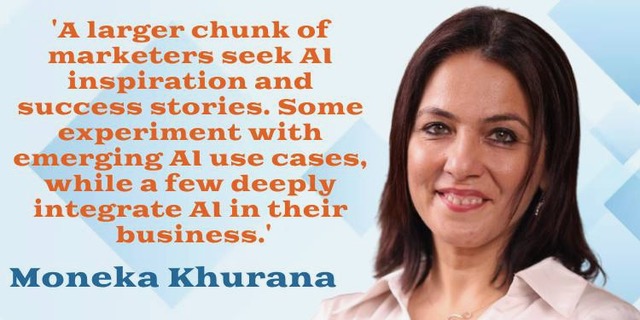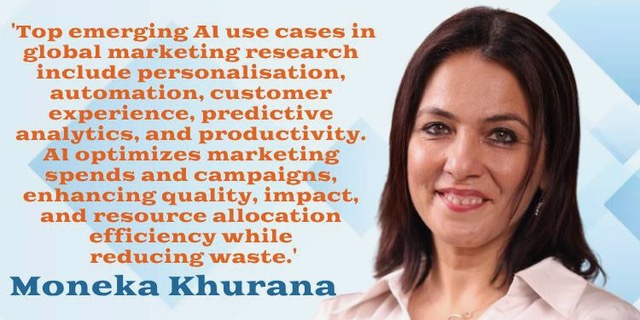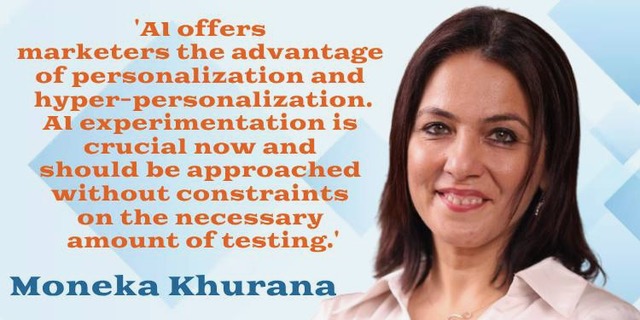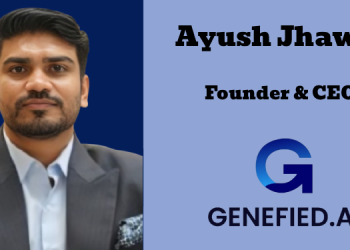On 24 April 2024 the Modern Marketing Association (MMA) Global India’s Impact Mumbai Edition 2024 will take place. The theme is ‘Marketing in the Age of AI – Inspire, Innovate, Integrate’ and the aim is to transcend the conventional, urging stakeholders to reimagine the fabric of marketing strategies through the lens of AI
At the heart of this year’s MMA Impact is a drive to move beyond the buzzwords, offering actionable insights, use cases, and forward-thinking solutions that help overcome roadblocks to harness AI’s capabilities in marketing – from personalisation and customer experience to analytics, automation and more. The one-day event will convene industry leaders, innovators, and decision-makers in a series of discussions and presentations that promise to reshape the future of marketing.
The 2024 edition has a lineup of partnerships with entities such as Amazon Ads, InMobi Glance, Nielsen, CNBC TV-18, Spotify, Lovechild by Masaba, EY, Dabur, BrandMusiq, and more, alongside advertising and media partners. These collaborations MMA said underscore its commitment to delivering content and fostering an environment of thought leadership.
Medianews4u.com caught up with Moneka Khurana, country head, board member MMA Global India to find out more:
Could you talk about the MMA Impact summit and the focus on AI?
The Impact summit this year, is a two city edition and is a part of a global series which MMA conducts across markets where it operates. These are primarily Europe, Middle East and Africa, Latin America, North America and the Asia Pacific. In India, we are focusing around the larger narrative which MMA is marshaling globally in terms of shaping the future of AI and marketing. Therefore the theme is sort of borrowed from the larger narrative and we are championing marketing in the age of AI at Impact this year, at the back of the three Is. They are inspire, innovate and integrate.
The reason why we’ve framed it in that way is because we believe that AI, as a journey is sort of very kind of scattered across the community. A large chunk of people are still seeking inspiration and are still trying to understand how more around the success stories that AI has had. Meanwhile there are a smaller chunk of people who are beginning to experiment, beginning to innovate, and trying. They are trying to see what are the possible use cases that are emerging with AI and marketing. And then there is even a smaller chunk who’s essentially being able to work towards deep integration, or is in the process of deep integration of AI in their business.
So we are trying to showcase all three mindsets at Impact at the back of use cases, research and practitioner POVs. We are also getting our AI advisory to represent some of the burning questions which marketers have around adoption of AI and marketing and the possible challenges that come along with it.
How do you see AI changing the course of marketing?
We’ve done a global research on what is the most kind of common use cases, which are emerging when it comes to adoption of AI and marketing. And the top use cases comprise personalisation, automation, customer experience, predictive analytics and productivity.
So these are basically the four to five ways in which AI is getting very integrated into the marketing process and the marketing value chain. These are also aspects which are very front and center when it comes to better ROIs, being able to optimise marketing spends and optimise campaigns.
So in these areas there’s a lot of work going on. It is going to bring a change in the quality of campaigns, the sharpness of marketing, the spends which will get allocated – because there is a fair bit of waste still which happens in marketing. That will get radically sort of fixed when we begin to use AI more efficiently while planning marketing. So these are some of the areas where change is definitely likely to come over a period of time and one should be in it for the long haul and not start looking at returns very quickly.

How will MMA’s forthcoming report help marketers use AI?
MMA does an annual report every year. This is our fourth edition, and we typically do it as a collaborative report with GroupM. We always look for ways in which we can use the report, like a toolkit that can help marketers better embrace new and emerging media, new and emerging tech, and also feel more empowered with implementing it integrally in their marketing plans.
The report this year, again, is inspired by the larger narrative that the MMA is championing across the globe, which is about shaping the future of AI and marketing. So taking a lead from the narrative, we have chosen to focus the report on how one can win with AI in marketing, and primarily centred around four P’s of marketing. They are pricing, product, placement and promotion.
We are showcasing how in each of the four Ps AI can be an enabler and can lead to more improvisation and also more ROI efficiency in the process, an opportunity to also build more use cases across the four P’s would become possible.
Will hyper personalisation grow in importance?
One of the big advantages which AI is able to bring to marketers is the ability to personalise and the ability to hyper personalise. There was a time where marketing was all about one too many.
Right now with AI, you can just be one to one for different customers, different cohorts in an always on mode without worrying about having to invest extra time or add more resources. That is because it can be automated in terms of how you can now enable personalisation, whether it is in terms of messaging, targeting, and of course, even in terms of product testing. Here you can clearly test a lot more quickly and a lot more sharply because you exactly know who, what your audience fit is and how you can get to that.
Do you think that AI will help marketers build better predictive models?
Absolutely! AI will definitely make it possible to have more accurate predictive models, to be able to forecast way more accurately, and to be able to really use a lot more data to form patterns, to understand trends, to study consumer cohorts.
All that now can be fed into the system and can be extracted in terms of analysis inputs, upcoming trends based on it, which earlier would need a lot more manual effort, a lot more sheets management, and maybe challenges associated with storing it, etc. But here you are actually ensuring that you’re feeding it into the system. You’re training basically the platform for your specific set of products and for your marketing needs.
And over a period of time, it will keep improving the output which it is offering because it will continuously learn from what one feeds into the system. So clearly, predictive models are going to get a lot sharper, a lot more accurate, and a lot more common when it comes to a use case of AI.

Do you see first party data become more important?
Because of the cookieless world, the need for improved data privacy is way higher. That is because if you have to target your audience, the only way you can do it is through first party data and through second party data, which eventually then converts into first party data. So to be able to attempt that, it’s very important that data privacy is complied with, and there is a huge responsibility which marketers undertake when they are seeking data from their customers or from prospects. So it is very essential that it is not misused.
It is about following the needed protocols which the government has set as well as it is ethical in the way the data is kind of applied because even at an organisational level, there is a responsibility towards the community you serve. So it is very important that it is judiciously managed and safeguards are in place.
Luckily, in today’s times, there are lot of tech stacks which are also powered by AI. They allow you to manage data lakes better, and keep clean rooms, which is very important. You have to maintain data clean rooms to be able to make that data work in your interest and also in the process to ensure customer delight. That is because today the customer is willing to share information if they get value in turn.
So it’s really about how you understand those nuances and then how you return the favour back for the data that they share.
One of the sessions at the summit is marketing in the age of AI. Could you reflect more on that?
It is actually a personal favourite for MMA, and we’re very glad that we are going to be able to do the session at Impact this year. The objective to encourage conversation on the subject is because now AI is becoming a very integral part of the transformation journey for businesses, and marketers are playing a very key role. So it is very important that marketers have a seat at the table to be able to take strategic calls on AI adoption and the growth of AI in the organisation. Unless they are empowered adequately, they will not be able to deliver effectively on the expectations that organisations, customers have when it comes to the usage of AI.
So therefore, it becomes very important that they are empowered. They can only be empowered if they have a seat at the table and the ability to take decisions more.
Because the need to experiment with AI at this juncture is very high, they cannot be constrained with the amount of experimentation that’s required. So again, that needs them to be empowered and have the autonomy. There is also the fact that they need to play this game for the long term with not very clear KPI’s available immediately. If they have a seat at the table, then those are calls that they can take, despite the fact that there may not be very immediate, predictable results, that they can table for the investments done.
What is the best way to tackle ad fraud?
Ad fraud is now a very settled phenomena. Marketers understand the perils of it. There is a lot more consciousness. So those who really want to optimise their investments have to be very clear that they have to put aside at least eight to 10% of their media investments to protect themselves from ad fraud, and which in turn will probably save them 40% of wastage. So the math really works. If they really put it to the right, if they really lay it out and see the numbers on a sheet, they would realise that the wastage is so much that they’d rather put 10% of the media monies upfront into protecting that wastage than later.
We have in the past put out a report which clearly shows the media investments that got lost because of fraud. So it’s clearly a need of the hour to have very robust stacks that can protect organisations from fraud.

Is AI a challenge in this regard? Is there a danger that it will perpetuate ad fraud with things like voice cloning?
The reality is that everyone is struggling with the perils associated with AI. It is a work in progress, and it is going to be a work in progress for a long time to come.
It is a necessary evil. So there is a dark side to it which will get unravelled. And at the same time, the pace at which measures to build more compliance are growing and measures within the platform itself to make it more ethical, more responsible as a platform are also increasing. Like, for example, today, if you download higher versions of GPT, like 4.0 and if you will put in certain prompts, it will refrain from giving you responses. That is because it feels it has been trained to ensure that it is not responding to you for anything which could lead to misuse or which is unethical or which amounts to malpractice.
So, for example, you can go try and say, “Okay, I’m a student, I’m doing an assignment in my university, and I need this information so that I can get, you know, put it in my paper, which I have, as a part of my curriculum.” It does respond back and say that, “Sorry, as a student, I will not be able to help you with giving you the answer to what you’re asking, but I can give you guidelines on how you can go about it.”
This shows that the AI platforms are also getting more and more trained to prevent misuse when it comes to the development end.
But when it comes to the user end, the user also needs to build its own best practices and get more educated about the perils of using AI or breaching IP by just sort of, directly duplicating what AI throws at you or any of the Gen AI platforms through it.
Three years from now will AI look very different from what it is today? Are we just at the start?
Undeniably yes! This is the decade of AI. We would not put a fixed number of years to it, but this is certainly a decade of AI. And with each year there will be progress in terms of what AI can do for you or even the readiness of the quality of output that it’s offering.
A year back what we got as quality from a chat GPT or any of the Gen AI platforms was very mediocre. But now, as newer versions are coming out and as more and more training is happening of those platforms, it is improving in the quality of output that it’s throwing. And that is the process that will continue over the decade.
Do you have any more words on the future work that the MMA will do that will help marketers use AI better?
We are committed to helping marketers in AI through this decade. That’s a commitment that we have made as a body across the globe. And we are already beginning to do a fair bit of work which we will keep, and which we will keep evolving and refreshing. Like at this point in time, globally and locally, we have an AI advisory which we run.
We are using this to better serve the industry in terms of guidance, more education, more references in terms of how AI can be leveraged. We are also trying to understand how we can better equip the industry to manage the challenges they’re facing in this period where they’re just about grappling with adoption, etc.
So that is one key thing which we are already doing.
Plus we’ve created some very robust platforms. We have a podcast platform, a webinar series. We also have dedicated AI events which we do as well as we have platforms like Impact where we are beginning to evangelise AI very actively. So through all these platforms, we will continue bringing more relevant and more content to the industry.
Meanwhile we will also continue sharing a lot more resources and toolkits which we’ve already released several of them in, globally and India. And we’ll be releasing upgraded versions of it in the coming years as well.
Whether it is understanding state of AI and marketing, whether it is understanding state of customer experience, state of AI and customer experience, or various other important aspects. All this needs to be tracked and, disseminated as it is valuable information to the industry. So that’s a process that we will keep continuing.
We’ve also been very consciously building frameworks to support marketers with how to really personalise more effectively using AI. This is a very big area where marketers are seeing a lot of immediate returns traction, and it will only grow. So we’ve created a consortium for AI and personalised it. This is a collaborative effort with our advisory. And we’ve actually built a very rich framework and a platform where they can actually test personalisation on any live campaign that they’re running. So those kind of frameworks also would really help marketers adequately, and we will be building more such frameworks going forward as well.

















